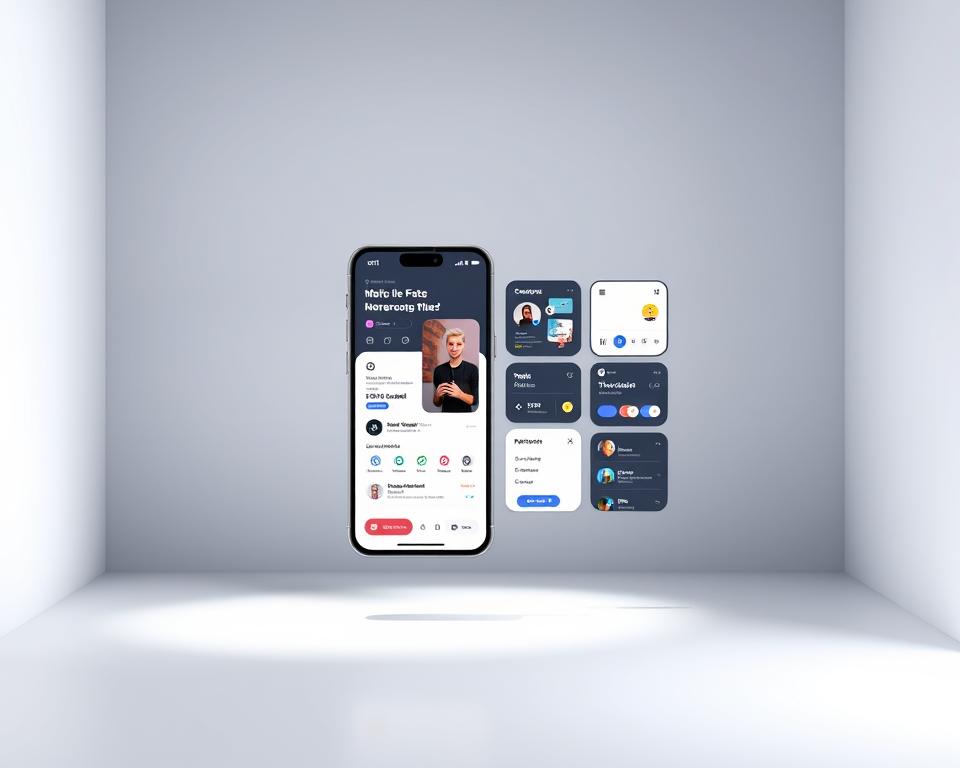Developers often struggle to choose between Flutter and Swift for iOS app development. Both have their own advantages and disadvantages. The right choice depends on the project’s needs. Flutter is popular for creating apps for both iOS and Android with one codebase. Swift, on the other hand, offers top-notch performance and works well with iOS devices.
Understanding the benefits of cross-platform and native app development is key. Cross-platform development is faster and cheaper. Native app development, however, provides a smoother user experience. This article will help you choose between Flutter and Swift for your next iOS app project.
Table of Contents
Introduction to iOS App Development
iOS app development is complex, needing careful thought on performance, security, and user experience. Cross-platform frameworks like Flutter make app development for multiple platforms easier. Yet, native frameworks like Swift still have an edge in performance and iOS integration.
Key Takeaways
- Flutter is a cross-platform development framework that allows for faster development and lower costs.
- Swift is a native app development framework that offers unparalleled performance and integration with iOS devices.
- iOS app development requires careful consideration of performance, security, and user experience.
- Cross-platform development can reduce development time and costs.
- Native app development provides a more seamless user experience.
- The choice between Flutter and Swift depends on the specific needs of the project.
Understanding the Fundamentals of Flutter and Swift
Mobile app development often involves choosing between Flutter and Swift. Flutter is known for its cross-platform approach, while Swift is great for iOS apps. Knowing the basics of each is key to making the right choice.
Flutter started in 2017 as an open-source project by Google. It’s popular for its simplicity and speed. Swift, introduced by Apple in 2014, is now the top choice for iOS apps. It’s modern and efficient.
What is Flutter?
Flutter is a Google-developed framework for mobile, web, and desktop apps. It uses Dart and has many widgets for UIs. It’s fast for building cross-platform apps.
What is Swift?
Swift is Apple’s modern language for iOS, macOS, and more. It’s clean and easy to use. Swift gives iOS apps a native feel, with great performance and security.
Core Differences Between Flutter and Swift
Flutter and Swift differ in their approach to app development. Flutter is for cross-platform apps, while Swift is for native iOS apps. Developers should think about their needs and project goals when choosing.
The Evolution of iOS App Development
iOS app development has seen big changes over time. New app development tools and development frameworks have made it easier. Now, iOS app development companies are more popular. They help developers make top-notch apps.
Several factors have driven these changes in iOS app development. These include:
- Advances in development frameworks, such as Flutter and Swift
- The growing need for iOS app development services
- The push for quicker and more efficient app development tools
The role of development frameworks has grown. They help make apps faster and better. iOS app development companies use these frameworks to create apps that users love.
In summary, iOS app development has evolved due to new tools and frameworks. As more people want iOS app development services, we’ll see even more progress in this field.
| Development Framework | Benefits |
|---|---|
| Flutter | Faster development times, improved app performance |
| Swift | Easy to learn, high-performance apps |
Key Features of Flutter for iOS Development
Flutter is a great choice for iOS app development. It’s known for its cross-platform development abilities. This means developers can make apps for both iOS and Android with just one codebase. This saves time and money, making it perfect for businesses wanting to reach more people.
Benefits of Cross-Platform Development
The Flutter framework has special tools for making top-notch apps for mobile, web, and desktop. Using Flutter for cross-platform development offers many benefits:
- Faster development and deployment
- Reduced costs
- Improved code sharing and reuse
- Enhanced collaboration and communication among developers
Flutter also has hot reload, which lets developers see code changes instantly. This makes testing and improving apps much quicker.
Widget-Based Development
Flutter’s widget-based approach makes building UIs easy and fun. Developers can use pre-made widgets to craft custom UI elements. This method helps in creating consistent and attractive designs across platforms.
With cross-platform development, hot reload, and widget-based design, developers can make amazing mobile apps with Flutter. It’s great for both simple apps and complex projects in mobile app development.
Swift’s Native Advantages in iOS Development
Swift is a top choice for native app development on iOS. Apple created Swift to help developers make strong, modern apps. It has a clean and simple syntax.
Using Swift for iOS app development brings many benefits. These include high performance, strong security, and easy use with Apple tech. Key advantages include:
- Faster execution and compilation
- Improved memory safety
- Seamless integration with other Apple frameworks and libraries
Swift helps developers make apps that are fast, secure, and reliable. Its modern design and syntax make creating high-quality apps easier. This meets today’s user needs.
Swift’s native benefits make it perfect for iOS app development. It lets developers build powerful, modern apps that use the latest Apple tech.
| Benefits | Description |
|---|---|
| Faster execution | Swift’s compiler and runtime environment are optimized for performance |
| Improved memory safety | Swift’s memory management system helps prevent common programming errors |
| Seamless integration | Swift integrates easily with other Apple frameworks and libraries |
Performance Comparison: Flutter vs. Swift for iOS Apps
When making iOS apps, app performance is key. Both Flutter and Swift have their good and bad points. Flutter uses a garbage collector, which can cause problems if not managed well. Swift, on the other hand, uses Automatic Reference Counting (ARC) for better memory handling.
Swift is a bit faster than Flutter at runtime. But, Flutter’s performance can get better with the right tweaks and caching. Here’s a quick look at how Flutter and Swift compare:
| Feature | Flutter | Swift |
|---|---|---|
| Memory Management | Garbage Collector | Automatic Reference Counting (ARC) |
| Runtime Performance | Good, but can be improved with optimization | Excellent |
| App Size | Generally larger than Swift apps | Generally smaller than Flutter apps |
Choosing between Flutter and Swift depends on your project’s needs. Think about app performance, memory management, and runtime performance. This way, you can make a smart choice and build top-notch apps.
Development Speed and Time-to-Market Analysis
In iOS app development, development speed and time-to-market are key. The right app development tools can greatly affect these. We’ll look at how Flutter and Swift compare in these areas.
App development speed is influenced by project complexity, team experience, and tool choice. Flutter’s cross-platform nature can cut down on development time and costs. Swift, being native, offers quicker access to iOS features, speeding up time-to-market.
Here are some key points to consider when evaluating Flutter and Swift:
- Flutter: Its cross-platform nature, hot reload, and large developer community make it fast.
- Swift: Being native, it gives direct iOS access and focuses on security, leading to quicker releases.
In conclusion, choosing between Flutter and Swift depends on project needs. By weighing development speed, time-to-market, and tool choice, developers can make the best decision for their goals.
| Development Framework | Development Speed | Time-to-Market |
|---|---|---|
| Flutter | Faster | Slower |
| Swift | Slower | Faster |
Cost Considerations Between Flutter and Swift Development
Cost is a big deal in iOS app development. Both Flutter and Swift have their own cost impacts. It’s key for businesses and developers to know these differences. We’ll look at the costs of starting a project, keeping it running, and hiring a team for both Flutter and Swift.
Flutter and Swift have different starting costs. Flutter’s ability to work on many platforms at once saves time and money. Swift, being native, needs separate code for each platform, which costs more.
Initial Development Costs
Here are some key factors to consider:
- Flutter: Lower initial development costs due to shared codebase
- Swift: Higher initial development costs due to separate codebases
Maintenance Expenses
Maintenance costs are also important. Flutter’s single codebase makes it easier to keep apps up to date, saving money. Swift’s native apps need more upkeep, which costs more.
Team Hiring Costs
Hiring a team also costs differently for Flutter and Swift. Flutter developers can work on both iOS and Android, saving on team costs. Swift developers focus on iOS, which means higher team costs.
In conclusion, the costs of using Flutter versus Swift are significant. Knowing the differences in starting costs, upkeep, and team costs helps businesses and developers make better choices for their iOS app projects.
UI/UX Capabilities and Limitations
When it comes to UI/UX design, Flutter and Swift have their own strengths and weaknesses. A good UI/UX is key for a successful app. It affects how users feel and how much they use the app. Developers use app development tools and development frameworks to make the app easy to use and look good.
Some important things to think about in UI/UX design are:
- Intuitive navigation and layout
- Consistent visual design and branding
- Seamless user interaction and feedback
Developers can use the right development frameworks and app development tools to meet their audience’s needs. For instance, Flutter’s widget-based approach makes quick prototyping and testing easy. Swift’s native features offer a smooth user experience.
In conclusion, the right UI/UX design choice depends on the project’s needs. Developers should weigh the pros and cons of each framework to make a user-friendly app.
| Framework | UI/UX Capabilities | Limitations |
|---|---|---|
| Flutter | Rapid prototyping, widget-based development | Steep learning curve, limited native integration |
| Swift | Native advantages, seamless user experience | Complex development process, limited cross-platform support |
Learning Curve and Developer Experience
When it comes to iOS app development, the learning curve and developer experience are key. A smooth learning curve and a positive experience can greatly impact the project’s success. For example, Flutter app development has a gentle learning curve, making it easier for developers to start.
The developer experience is also shaped by the availability of resources and community support. Community support is crucial for solving problems and keeping up with framework updates. A strong community offers valuable feedback, shares knowledge, and guides developers, improving their experience.
Several factors influence the learning curve and developer experience. These include:
- Documentation and tutorials
- Code complexity and readability
- Debugging and testing tools
- Community support and forums
By considering these factors, developers can choose the right framework for their iOS app projects. This leads to a better learning curve and developer experience.
As the demand for skilled developers grows, it’s vital to focus on a positive developer experience. Providing the necessary resources supports a smooth learning curve.
| Framework | Learning Curve | Developer Experience | Community Support |
|---|---|---|---|
| Flutter | Gentle | Positive | Strong |
| Swift | Steep | Challenging | Good |
Integration with Third-Party Services and APIs
Integrating with third-party services and APIs is key in iOS app development. It boosts the app’s features and user experience. Both Flutter and Swift make it easy to connect with many services, making apps more powerful and rich.
Developers use tools to add third-party services and APIs to apps. This makes building apps faster and cheaper. For example, Google Maps adds location services, and Facebook helps with social media login.
Integrating with third-party services and APIs brings many benefits. These include:
- Enhanced app functionality
- Improved user experience
- Reduced development time and costs
- Increased scalability and flexibility
By using these services, developers can focus on the app’s core features. This way, they can build more complex apps without starting from scratch.
In summary, working with third-party services and APIs is vital in iOS app development. Both Flutter and Swift provide the tools needed for smooth and efficient integration.
| Third-Party Service | API | App Development Tool |
|---|---|---|
| Google Maps | Google Maps API | Flutter |
| Facebook API | Swift |
Testing and Debugging Capabilities
Testing and debugging are key in iOS app development. They make sure the app works well and is reliable. Flutter and Swift have tools for this, like automated testing and debugging features. These help find and fix problems fast, saving time and money.
Automated testing tools are very important. They let developers write and run tests automatically. This means the app is checked without manual effort. Tools like JUnit and XCTest are popular for Flutter and Swift. They help make testing easier, so developers can work on other parts of the app.
Automated Testing Tools
- JUnit: A popular testing framework for Flutter
- XCTest: A built-in testing framework for Swift
Debugging features are also crucial. They help find and solve problems. Features like print statements, debuggers, and log analysis give insights into app performance. Using these with automated testing tools ensures the app is well-tested and works smoothly.
Debugging Features
Flutter and Swift have many debugging features. Print statements, debuggers, and log analysis are some examples. They help developers understand how the app performs. This way, they can fix issues and make the app stable and efficient.
Market Adoption and Industry Trends
The adoption of Flutter and Swift in iOS app development is key. As mobile app demand rises, the focus shifts to tools that are efficient and affordable. Both Flutter and Swift have their own benefits and drawbacks, making it crucial to understand their market position.
Factors like ease of use, performance, and cost influence tool adoption. Cross-platform tools like Flutter have seen a big rise in popularity. They let developers build apps for both iOS and Android with just one codebase.
There’s a growing need for apps that offer a smooth user experience. Developers are using tools with advanced features like hot reload and widget-based development to meet this need. This trend is expected to keep growing as more see the value in these tools.
Flutter and Swift have different strengths and weaknesses in terms of market adoption. Swift has a larger developer community, but Flutter is gaining ground due to its simplicity and cost-effectiveness. The choice of tool depends on the project’s needs, and the market is likely to evolve with industry trends.
Security Considerations and Best Practices
Security is key in iOS app development. Both Flutter and Swift have their own strengths and weaknesses. It’s important to think about security when picking a framework. This helps protect user data and keeps it safe from unauthorized access.
Developers need to know the risks and vulnerabilities of each framework. They should make sure sensitive data is encrypted and stored safely. They also need to use proper ways to check who can access the app. By doing these best practices, developers can lower the chance of security problems and make sure their apps are safe and work well.
Flutter Security Features
Flutter has several security features, including:
- Encryption: Flutter has built-in encryption for sensitive data, making it harder for unauthorized parties to get to.
- Secure storage: Flutter has secure storage options, like the KeyStore, to keep sensitive data safe.
- Authentication: Flutter has ways to make sure only authorized users can get into the app, like OAuth.
Swift Security Advantages
Swift has several security advantages, including:
- Native security features: Swift has built-in security features, like Address Space Layout Randomization (ASLR), which makes it harder for attackers to find vulnerabilities.
- Secure coding practices: Swift encourages developers to use secure coding practices, like secure protocols for data transmission.
- Regular updates: Swift gets regular updates, which helps fix security problems and keeps the framework safe.
By thinking about security and following best practices, developers can make sure their iOS apps are safe and reliable. It’s important to focus on security features and follow best practices, no matter if you’re using Flutter or Swift. This helps lower the risk of security breaches.
| Framework | Security Features | Best Practices |
|---|---|---|
| Flutter | Encryption, secure storage, authentication | Use secure protocols, validate user input |
| Swift | Native security features, secure coding practices | Use secure protocols, keep software up-to-date |
Long-Term Maintenance and Scalability
In iOS app development, long-term maintenance and scalability are key. The tools you choose can greatly affect how easy it is to keep and grow your app. For example, Flutter makes long-term maintenance simpler by letting developers work on one codebase for both iOS and Android.
Flutter also makes it easy to add new features as your app grows. Its app development tools offer features like hot reload and a big community of developers. This helps a lot with scalability.
When picking a framework, think about these important points:
- How complex the code is and how easy it is to keep up with
- The support and resources from the community
- How flexible and adaptable the framework is
By looking at these factors and picking the right app development tools, developers can make sure their app is ready for the future. This leads to a more successful and lasting app.
| Framework | Long-term Maintenance | Scalability |
|---|---|---|
| Flutter | Easy maintenance with a single codebase | Highly scalable with widget-based development |
| Swift | Native advantages for maintenance | Scalable with native iOS development |
Conclusion
Choosing between Flutter and Swift for iOS app development is key. Both have their own advantages and disadvantages. Swift is great for making native iOS apps that perform well. On the other hand, Flutter is perfect for those who want to build apps for multiple platforms quickly.
For more details on Flutter vs Swift, check out iOS app development resources. They offer deep insights into app development tools.
The choice between Flutter and Swift depends on your project’s needs. Knowing the differences helps developers pick the right tool for their iOS app project. With the right tools and knowledge, businesses can make apps that are both high-quality and user-friendly.



















